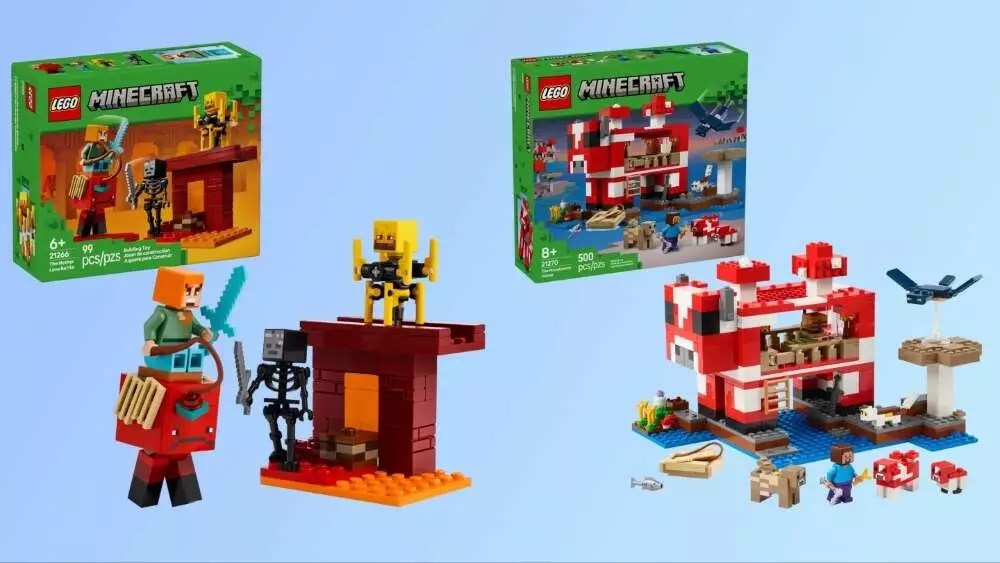Lego has once again unleashed a fresh assortment of Minecraft-themed sets, piquing the interest of fans and builders alike. As someone who closely follows the evolution of Lego and its crossover into the Minecraft universe, I find the latest launches admirable but not without their critiques. This article delves into the new sets, their design intricacies, and the overall Lego strategy in relation to one of the most beloved gaming franchises.
As of January 1, five newly released Lego Minecraft sets have begun to grace the aisles of Amazon, the Lego Store, and major retailers across the board. These new additions, ranging from the compact Nether Lava Battle for $10 to the more expansive Mooshroom House priced at $50, signify a strategic move to appeal to varying demographics. While smaller-scale playsets may attract younger audiences and casual gamers, experienced Lego builders might crave something more substantial, which is where the previously released Crafting Table set comes into play.
The Crafting Table model, with its impressive 1,195 pieces, was specifically tailored for adult Lego enthusiasts, a noteworthy pivot for Lego that reflects its understanding of a shifting target audience. However, the question arises: does Lego’s newer lineup capture the imaginations of adult fans, or does it feel like a departure from the complex building experiences they’ve come to expect?
Interestingly, this launch coincides with over 100 additional Lego sets drawn from various popular entertainment franchises, including Mario Kart, Sonic the Hedgehog, and Star Wars. While it’s commendable to have multi-franchise support, the risk of dilution looms large. With so many offerings vying for consumer attention, will the nuanced craftsmanship that Lego is known for begin to erode? Each Minecraft set brings its own charm, yet they must compete not only amongst themselves but also against a diverse range of toys and collectibles.
For instance, the Mooshroom House’s enticing elements—a Steve figurine, vibrant mooshroom figures, and an array of accessories—stand out, yet the market is flooded with options. As someone who often engages with Lego’s intricate world-building, the scale seems both delightful and daunting; how does one choose?
Consider Lego’s previous hit, the Mushroom House set, which became highly sought after upon selling out. In leveraging nostalgia and familiar themes, such as the Baby Pig House featuring a delightful assortment of pig-themed characters, Lego finds an effective way to engage existing fans. However, the challenge lies within sustainability; how many iterations of these themes can be created before consumer fatigue sets in?
Moreover, Lego has angled toward introducing multifaceted play experiences, which is evident with sets like The Armadillo Mine Expedition, where players can reveal hidden treasures using a lever-operated TNT brick. While many might find such features engaging, I wonder if they add layers of complexity that might overwhelm younger audiences or those less familiar with intricate gameplay mechanics.
In parsing the price points associated with these new sets, I’m drawn to the concept of perceived value. The smallest set, costing just $10 with 99 pieces, seems like an enticing entry point, yet it leaves one pondering the cost-to-piece ratio as compared to larger, more complex sets. This pricing strategy may lure in cost-conscious parents yet risks presenting a diminished value for seasoned Lego aficionados who seek robust building experiences rather than a quick, simple build.
The retired Illager Raid set, for example, has surged in collectibility, revealing a trend: as products retire, they often skyrocket in demand. This is a clever marketing tactic but also raises questions regarding long-term fulfillment for fans. Limited editions create urgency, but they also foster dissatisfaction for those unable to procure them at retail prices.
The latest Lego Minecraft sets embody a strategic blend of nostalgia, innovation, and perhaps, market fatigue. While they cater to both nostalgic and new fans, the diversity in scale and complexity necessitates a careful navigation through the brand’s range. The challenges of perceived value, tactful gameplay integration, and collectibility play a multifaceted role in captivating audiences while risking dilution of the Lego experience.
As I reflect on these new additions, I remain excited yet cautiously optimistic about their potential impact. With every tiny brick laid, the spirit of creativity flourishes, but the quest for balance between complexity and playability remains an ongoing journey for this iconic toy brand. The question remains: will these whimsical new adventures in the Minecraft world strengthen the bond Lego shares with its community or lead to a fragmentation of its ever-expanding universe? Only time will tell as fans continue to build and create.


Leave a Reply